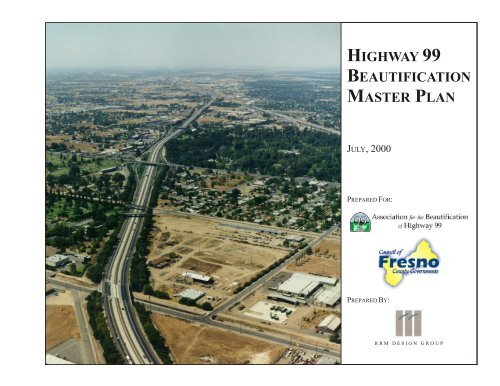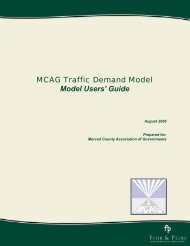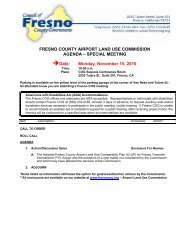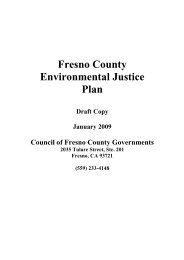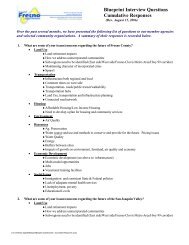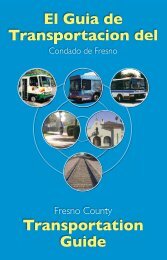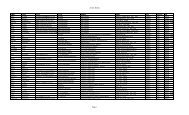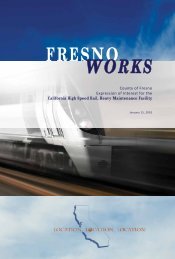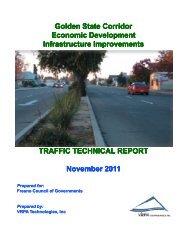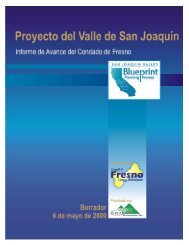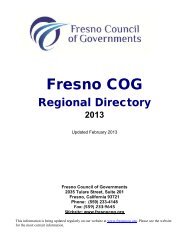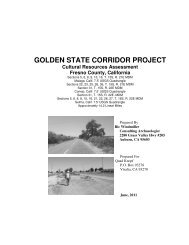Highway 99 Beautification Master Plan - Council of Fresno County ...
Highway 99 Beautification Master Plan - Council of Fresno County ...
Highway 99 Beautification Master Plan - Council of Fresno County ...
- No tags were found...
Create successful ePaper yourself
Turn your PDF publications into a flip-book with our unique Google optimized e-Paper software.
HIGHWAY <strong>99</strong>BEAUTIFICATIONMASTER PLANJULY, 2000PREPARED FOR:PREPARED BY:R R M D E S I G N G R O U P
TABLE OF CONTENTSIntroduction .............................................................................................The <strong>Plan</strong>ning Process ...............................................................................Goals and Objectives ...............................................................................Opportunities and Constraints ...................................................................151117<strong>Highway</strong> <strong>99</strong><strong>Beautification</strong><strong>Master</strong> <strong>Plan</strong>Proposed <strong>Beautification</strong> Improvements .....................................................Aesthetic Treatment Options .....................................................................Landscape and Architectural Guidelines ....................................................Implementation .........................................................................................Appendix I. Existing Conditions Photos ..........................................27566577iiAendiTable <strong>of</strong> ContentsAppendix II. Funding Resources ...................................................... xivAppendix III. Aendi<strong>Plan</strong>t Palette ................................................................ xviAppendix IV. Visitor’s Center Concept ............................................. xxiiTable <strong>of</strong>ContentsAppendix V. Bibliography ................................................................xxiii
INTRODUCTION<strong>Highway</strong> <strong>99</strong><strong>Beautification</strong><strong>Master</strong> <strong>Plan</strong>
IFNTRODUCTIONresno <strong>County</strong> is in the heart <strong>of</strong> the San Joaquin Valley <strong>of</strong> California. The Valley is surrounded by mountains.They are, mainly the majestic Sierra Nevada range in the east and the rolling California Coastal range in the west.It is a flat region that stretches for nearly 300 miles from the Tehachapi Mountains in the south to the San JoaquinDelta in the north. The climate is considered Mediterranean, with long, warm summers and short, cool winters.<strong>Highway</strong> <strong>99</strong><strong>Beautification</strong><strong>Master</strong> <strong>Plan</strong>The Valley is very dry, but irrigation projects such as the Central Valley Project and the State Water Project havemade it the agricultural heartland <strong>of</strong> California. The top three agricultural counties in the U.S. (<strong>Fresno</strong>, Tulare,and Kern) are in the San Joaquin Valley. Producing more than $3 billion worth <strong>of</strong> goods each year, <strong>Fresno</strong><strong>County</strong>’s agricultural industry is the most lucrative in the entire nation. <strong>Highway</strong> <strong>99</strong> runs through the center <strong>of</strong> the<strong>County</strong>, generally in a northwest to southeast direction. Four incorporated cities are located along the 31.59 milecorridor: <strong>Fresno</strong>, with a population <strong>of</strong> 415,400; Fowler, with a population <strong>of</strong> 3,830; Selma, with a population <strong>of</strong>18,450; and Kingsburg, with a population <strong>of</strong> 9,225. <strong>Fresno</strong> <strong>County</strong> is also the only county in the Nation locatedwithin an hour drive <strong>of</strong> three national parks (Yosemite, Kings Canyon, and Sequoia).AppendixIntroduction<strong>Fresno</strong> <strong>County</strong> typically has chronic unemployment. Consequently, jobcreation and economic development are very important to the area. It isbelieved by many in the <strong>County</strong> that the substandard appearance <strong>of</strong><strong>Highway</strong> <strong>99</strong> and many <strong>of</strong> the adjacent properties discourage businessesfrom investing in the area. Businesses tend not to invest in communitiesAppendixIntroduction2
that don’t invest in themselves. Creating and maintaining an attractive civic image is one <strong>of</strong> the basic investmentsa community can make.<strong>Highway</strong> <strong>99</strong><strong>Beautification</strong><strong>Master</strong> <strong>Plan</strong>This project originated from a common desire to improve the image <strong>of</strong> <strong>Highway</strong> <strong>99</strong> and thus attract economicdevelopment. As many as 100,000 cars per day pass through <strong>Fresno</strong> <strong>County</strong> on <strong>Highway</strong> <strong>99</strong> and many <strong>of</strong> thesedrivers form their only impression <strong>of</strong> <strong>Fresno</strong> <strong>County</strong> from what they see on the corridor. The present condition<strong>of</strong> the <strong>Highway</strong> and many <strong>of</strong> the adjacent properties reflects very poorly on the cities through which the <strong>Highway</strong>passes and the <strong>Fresno</strong> <strong>County</strong> in general. A lack <strong>of</strong> landscaping, infrequent maintenance <strong>of</strong> existingplantings, a proliferation <strong>of</strong> billboards, and unsightly adjacent land uses make much <strong>of</strong> <strong>Highway</strong> <strong>99</strong> unattractive.The unsightly views <strong>of</strong> <strong>Highway</strong> <strong>99</strong> contribute to a negative community image among area residents and discouragewould-be tourists from entering the adjoining cities.The Goal <strong>of</strong> This <strong>Plan</strong>:“Create, within ten years, an image for the <strong>Highway</strong> <strong>99</strong> corridor through <strong>Fresno</strong> <strong>County</strong> thatcommunicates to the traveling public the agricultural significance, economic strength, scenic beauty, andcommunity spirit <strong>of</strong> our region.”AppendixIntroductionAppendixThis is the challenge that the Association for the <strong>Beautification</strong> <strong>of</strong> <strong>Highway</strong> <strong>99</strong> and the <strong>Council</strong> <strong>of</strong> <strong>Fresno</strong> <strong>County</strong>Governments took on for themselves in the spring <strong>of</strong> 1<strong>99</strong>9. The following <strong>Beautification</strong> <strong>Master</strong> <strong>Plan</strong> is the firstproduct <strong>of</strong> that challenge. This plan addresses the visual resource management, landscape development, highwaymaintenance, public service operations issues, and inter-governmental relations that are inherent in theIntroduction3
effort to beautify the <strong>Highway</strong> <strong>99</strong> Corridor through <strong>Fresno</strong> <strong>County</strong>. It also <strong>of</strong>fers a program that will preserveand enhance the natural scenic beauty <strong>of</strong> the Corridor while recognizing and incorporating the commercialactivities adjacent to the Corridor necessary for the social and economic well-being <strong>of</strong> the related communities.In addition, this plan strives to identify and enhance the unique regional character <strong>of</strong> the <strong>Highway</strong> <strong>99</strong> Corridorthrough <strong>Fresno</strong> <strong>County</strong> and how it influences, and is influenced by, elements and activities beyond the immediateplanning area.<strong>Highway</strong> <strong>99</strong><strong>Beautification</strong><strong>Master</strong> <strong>Plan</strong>AppendixIntroductionAppendixIntroduction4
T HE PLANNING PROCESS<strong>Highway</strong> <strong>99</strong><strong>Beautification</strong><strong>Master</strong> <strong>Plan</strong>
TTHE PLANNING PROCESShis planning process was the culmination <strong>of</strong> efforts begun more than a year before the beginning <strong>of</strong> this study bya group <strong>of</strong> concerned citizens, business leaders, and policy makers in <strong>Fresno</strong> <strong>County</strong>. From this informal groupcame the Association for the <strong>Beautification</strong> <strong>of</strong> <strong>Highway</strong> <strong>99</strong> (in future reference “the Association”). Each cityalong the corridor and the <strong>County</strong> passed resolutions forming the Association. The <strong>Council</strong> <strong>of</strong> <strong>Fresno</strong> <strong>County</strong>Governments (in future reference the “<strong>Fresno</strong> COG”) agreed to provide staff support to the group. The CaliforniaDepartment <strong>of</strong> Transportation (Caltrans), who owns and operates <strong>Highway</strong> <strong>99</strong>, also agreed to participate inthe Association. As a result, a spirit <strong>of</strong> cooperation has been well established among the various agenciesrepresented along the highway.The Association for the <strong>Beautification</strong> <strong>of</strong> <strong>Highway</strong> <strong>99</strong> MembershipJuan Arambula, <strong>Fresno</strong> <strong>County</strong> Board <strong>of</strong> SupervisorsDeborah Nankivell, <strong>Fresno</strong> Business <strong>Council</strong><strong>Council</strong>man Dan Ronquillo, City <strong>of</strong> <strong>Fresno</strong>Tom McGowan, Automated OfficeSystemsMayor Joe Monis, City <strong>of</strong> FowlerJohn Taylor, resident <strong>of</strong> FowlerMayor Michael Derr, City <strong>of</strong> SelmaPete Esraelian, Selma <strong>Beautification</strong> Committee<strong>Council</strong>man Leland Bergstrom, City <strong>of</strong> KingsburgAppendixAppendix<strong>Highway</strong> <strong>99</strong><strong>Beautification</strong><strong>Master</strong> <strong>Plan</strong>The <strong>Plan</strong>ningProcessThe <strong>Plan</strong>ning Process6
Milo Smith, resident <strong>of</strong> KinsburgJose Ruano, Caltrans District 6<strong>Highway</strong> <strong>99</strong><strong>Beautification</strong><strong>Master</strong> <strong>Plan</strong>Associate MembersMark Keppler, CSUF Sid Craig School <strong>of</strong> BusinessVince Correll, HQ Business CentersTom Krazan, Krazan and AssociatesBob Belcher, Belcher FarmsAnne Speake, International English InstitutePaul McLain-Lugowski, <strong>Fresno</strong> <strong>County</strong> EOCSusan Stiltz, Tree <strong>Fresno</strong>Dan Fitzpatrick, <strong>Fresno</strong> Redevelopment AgencyThe consensus <strong>of</strong> the members <strong>of</strong> the Association was that the lack <strong>of</strong> visual appeal along <strong>Highway</strong> <strong>99</strong> hasdiscouraged economic development in the region. The various individuals and agencies involved in the Associationbelieve that by showing an effort to invest in their community’s image and aesthetic character, they willencourage existing businesses to invest in the area and attract new economic interests.AppendixIn an effort to accomplish this, the Association determined that the preparation <strong>of</strong> a <strong>Beautification</strong> <strong>Master</strong> <strong>Plan</strong>for the <strong>Highway</strong> <strong>99</strong> Corridor was a necessary first step toward accomplishing their goals. In addition, theyagreed that the <strong>Plan</strong> should contain funding and implementation strategies, as well as general policies that couldAppendixThe <strong>Plan</strong>ningProcessThe <strong>Plan</strong>ning Process7
e applied to other corridors in the county.<strong>Highway</strong> <strong>99</strong><strong>Beautification</strong><strong>Master</strong> <strong>Plan</strong>In the spring <strong>of</strong> 1<strong>99</strong>9 the group sent out a Request for Proposals (RFP) to qualified design firms to assist them inthe preparation <strong>of</strong> the <strong>Beautification</strong> <strong>Plan</strong>. After a thorough review and selection process, the Associationselected RRM Design Group to assist them in the preparation <strong>of</strong> the <strong>Plan</strong>. RRM’s team <strong>of</strong> landscape architectsand planners worked with the Association and <strong>Fresno</strong> COG in the preparation <strong>of</strong> this document through frequentreview <strong>of</strong> the work progress and products. The <strong>Plan</strong>’s work program was broken down into several phaseswhich are described in the following summary.PHASE IGoals and ObjectivesPhase I began with a start-up meeting with the Association in which the RRM design team collected additionalinformation, clarified timelines and milestones, and engaged in a brainstorming session on goals, objectives andproject boundary issues for the <strong>Master</strong> <strong>Plan</strong>. The second portion <strong>of</strong> this phase consisted <strong>of</strong> fieldwork and aninventory <strong>of</strong> existing conditions. RRM Design Group performed a thorough site review <strong>of</strong> the existing conditionsthroughout the <strong>Highway</strong> <strong>99</strong> Corridor study area. This included field notes, videotape and photographs <strong>of</strong> the studyarea as well as compilation <strong>of</strong> existing <strong>Highway</strong> <strong>99</strong> Corridor aerial photographs.AppendixPHASE IIExisting ConditionsThe second phase consisted <strong>of</strong> an Opportunity and Constraints Analysis. RRM Design Group analyzed theAppendixThe <strong>Plan</strong>ningProcessThe <strong>Plan</strong>ning Process8
ackground information from Phase I and collected additional data. After a preliminary set <strong>of</strong> goals and objectiveswere defined and integrated with the information gathered in Phase I, RRM prepared an Opportunities andConstraints Map and report. Positive and negative conditions in the Corridor were identified with solutions andalternatives for these conditions. Upon completion <strong>of</strong> existing condition analysis, RRM Design Group met againwith the Association to present the initial findings from the fieldwork. Major issues identified by the RRM designteam were reviewed and field verified by the Association. RRM then began the preliminary design concepts inPhase III.PHASE IIIPreliminary Design Concepts and DevelopmentPhase III involved the preparation <strong>of</strong> preliminary design concepts and the development <strong>of</strong> an overall concept planfor the Corridor. Utilizing base maps provided by the <strong>Fresno</strong> COG, and information review and input by theAssociation, RRM Design Group prepared design vignettes <strong>of</strong> typical cross sections to illustrate specific planideas such as thematic beautification features for the Corridor. Upon completion <strong>of</strong> this phase, RRM DesignGroup met with the Association members for a third time to present the concepts and receive comments anddirection for the Landscape and Architectural Guidelines in Phase IV.AppendixPHASE IVCorridor Development GuidelinesPhase IV saw the development <strong>of</strong> refined proposed <strong>Beautification</strong> Improvements and Aesthetic TreatmentOptions based on the Association’s review and comment. Further review with the Association finalized theAppendix<strong>Highway</strong> <strong>99</strong><strong>Beautification</strong><strong>Master</strong> <strong>Plan</strong>The <strong>Plan</strong>ningProcessThe <strong>Plan</strong>ning Process9
ecommendations and direction <strong>of</strong> the <strong>Beautification</strong> <strong>Master</strong> <strong>Plan</strong>. After careful review and consideration PhaseV began, which saw the completion <strong>of</strong> the <strong>Beautification</strong> <strong>Master</strong> <strong>Plan</strong> and Design Guidelines.<strong>Highway</strong> <strong>99</strong><strong>Beautification</strong><strong>Master</strong> <strong>Plan</strong>PHASE V<strong>Beautification</strong> <strong>Master</strong> <strong>Plan</strong> and Design GuidelinesBased on the input received from the Association, RRM Design Group prepared the final <strong>Highway</strong> <strong>99</strong> <strong>Beautification</strong><strong>Master</strong> <strong>Plan</strong> document. Large-scale plan graphics were also prepared for the Association’s use in presentation<strong>of</strong> the <strong>Master</strong> <strong>Plan</strong> to various public agencies and interested community groups. This final phase entailedincorporating comments on the draft <strong>Beautification</strong> <strong>Master</strong> <strong>Plan</strong> into a final document for the Association and the<strong>Fresno</strong> COG for use in promoting implementation <strong>of</strong> the <strong>Plan</strong> features, concepts and proposals.AppendixThe <strong>Plan</strong>ning ProcessAppendixThe <strong>Plan</strong>ningProcess10
G OALS AND OBJECTIVES<strong>Highway</strong> <strong>99</strong><strong>Beautification</strong><strong>Master</strong> <strong>Plan</strong>
G OALS AND OBJECTIVES<strong>Highway</strong> <strong>99</strong><strong>Beautification</strong><strong>Master</strong> <strong>Plan</strong>T hese goals and objectives were formed by the Association, with the assistance <strong>of</strong> RRM Design Group, to identifya vision for the <strong>Highway</strong> <strong>99</strong> Corridor and to guide the development <strong>of</strong> the <strong>Beautification</strong> <strong>Master</strong> <strong>Plan</strong>.GOAL 1:Create and sustain an image for the corridor that communicates to <strong>Highway</strong> <strong>99</strong> travelers the agricultural significance,economic strength, scenic beauty, and community spirit <strong>of</strong> the study area.Objective 1A:Inform and educate <strong>Highway</strong> <strong>99</strong> travelers on the economic, recreational, and cultural resources <strong>of</strong> the area.Policy 1A1:Explore the feasibility <strong>of</strong> creating a visitor center in conjunction with a Caltrans rest stop and the majorgateway at each end <strong>of</strong> the corridor. (See Appendix IV Visitor’s Center Concept)Policy 1A2:Explore the feasibility <strong>of</strong> creating a local am radio signal that transmits key information about the corridor.Policy 1A3:Develop a community out reach program using mailers, community service announcements, and volunteersto disseminate key information about the corridorAppendixGoals and ObjectivesPolicy 1A4:If it is not possible to eliminate billboards along the corridor (see Goal 2, Objective 2B), rent some billboardsfor educational and corridor promotionAppendixpurposes.Objective 1B:Define the corridor by creating major and minor gateways.GoalsandObjectives12
Policy 1B1:Establish major gateways at the northern and southern boundaries <strong>of</strong> the corridor.<strong>Highway</strong> <strong>99</strong><strong>Beautification</strong><strong>Master</strong> <strong>Plan</strong>Policy 1B2:Develop an architectural theme for major gateways reflecting the agricultural significance <strong>of</strong> the area.Policy 1B3:Explore the possibility <strong>of</strong> locating architecturally prominent agriculture processing facilities adjacent tomajor gateway sites.Policy 1B4:Establish minor gateways at the important city and district nodes.Policy 1B5:Develop an architectural theme for minor gateways emphasizing the unique characteristics <strong>of</strong> the associatedcity or district while maintaining a unified theme for the overall corridor.GOAL 2:Improve the visual appeal <strong>of</strong> the Corridor.Objective 2A:Strive to eliminate or greatly reduce roadside litter within the corridor.AppendixGoals and ObjectivesPolicy 2A1:Promote stronger enforcement <strong>of</strong> existing litter laws.AppendixPolicy 2A2:Identify major sources <strong>of</strong> roadside litter and develop a program to reduce the litter problem at the source.Policy 2A3:Augment existing trash collection efforts with additional sources, such as volunteer service groups,inmates, and court ordered community service personnel.GoalsandObjectives13
Policy 2A4:Educate the general public about the need to eliminate roadway litter.<strong>Highway</strong> <strong>99</strong><strong>Beautification</strong><strong>Master</strong> <strong>Plan</strong>Objective 2B:Eliminate sign pollution along the Corridor.Policy 2B1:Recommend incorporation <strong>of</strong> billboard elimination language in appropriate city and county ordinances forbillboards along the Corridor.Policy 2B2:Develop a strategy and funding for elimination <strong>of</strong> existing billboards. A phasing plan should be establishedalong with this strategy to maximize the visual impact <strong>of</strong> billboard removal throughout the Corridor.Objective 2C:Develop a landscape theme that unifies the study area, enhances its visual appeal, and emphasizes theunique elements <strong>of</strong> the component cities and districts.Policy 2C1:Create landscape elements that fulfill the various physical requirements necessary for corridor enhancementwhile maintaining a unified appearance for the overall corridor. Landscape elements should include,but are not necessarily limited to, hardscape and planting that screens, frames, complements, and enhancesthe corridor and adjacent communities. Implementing such elements will make the corridor saferfor travelers, more aesthetically appealing, and easier to maintain.AppendixPolicy 2C2:Develop a combination <strong>of</strong> fencing and ground plane treatments that highlight unique aspects <strong>of</strong> thevarious cities and districts within the corridor while maintaining and overall unified theme.AppendixGoalsandObjectivesGoals and Objectives14
Policy 2C3:Analyze existing tree, shrub, and ground cover species within the corridor. Rank species according totheir success in the categories <strong>of</strong> drought tolerance, pest and disease resistance, degree <strong>of</strong> maintenance,and aesthetic appeal. From this analysis determine which existing plant types should remain and beenhanced, and which should be phased out <strong>of</strong> use.<strong>Highway</strong> <strong>99</strong><strong>Beautification</strong><strong>Master</strong> <strong>Plan</strong>Policy 2C4:Draw on drought tolerant and native (local to the area) plant species for additions to the corridor plantpalette.GOAL 3:Encourage community involvement in the promotion, development, and maintenance <strong>of</strong> the corridor.Objective 3A:Develop volunteer programs that address promotion, physical improvements, and maintenance <strong>of</strong> the Corridor.Policy 3A1:Establish relationships with community leaders, government <strong>of</strong>ficials, and service group representatives.Lobby these contacts to provide volunteers and/or financial assistance for implementation <strong>of</strong> the programs.AppendixGoals and ObjectivesObjective 3B:Establish a non-pr<strong>of</strong>it organization for the promotion, development and maintenance <strong>of</strong> the corridor. Apply forgrant funding for creation <strong>of</strong> the non-pr<strong>of</strong>it as well as to support the promotion, physical improvements, andmaintenance programs for the Corridor.AppendixPolicy 3B1:Explore the possibility <strong>of</strong> incorporating the existing <strong>Highway</strong> <strong>99</strong> <strong>Beautification</strong> Committee into a non-pr<strong>of</strong>itorganization.GoalsandObjectives15
Policy 3B2:Create a permanent full-time paid position for an executive director. The executive director’s mission willbe to implement the plan.<strong>Highway</strong> <strong>99</strong><strong>Beautification</strong><strong>Master</strong> <strong>Plan</strong>AppendixGoals and ObjectivesAppendixGoalsandObjectives16
O PPORTUNITIES & CONSTRAINTS<strong>Highway</strong> <strong>99</strong><strong>Beautification</strong><strong>Master</strong> <strong>Plan</strong>
OPPORTUNITIES AND CONSTRAINTS<strong>Highway</strong> <strong>99</strong><strong>Beautification</strong><strong>Master</strong> <strong>Plan</strong>T he primary purpose <strong>of</strong> this plan is to improve the visual appearance <strong>of</strong> <strong>Fresno</strong> <strong>County</strong> and its cities from <strong>Highway</strong><strong>99</strong>. With this in mind, the following opportunities and constraints were identified.Element:Opportunity:Opportunity:Constraint:Element:Opportunity:Northern Limit <strong>of</strong> CorridorEnhancement <strong>of</strong> the bridge crossings will create the gateway experience. The natural grade isalso an advantage in this regard.Agricultural land use also sets the background here for a gateway monument. It appears thatthere is sufficient room for a rest stop and associated structures at the northern limit <strong>of</strong> theCorridor.Additional right <strong>of</strong> way may need to be acquired for proposed facilities. Caltrans is notcurrently planning roadside rest stops at this location.Entry Signs for Cities and CountiesUnifying signage would enhance the sense <strong>of</strong> unity in the corridor and increase traveller’ssense <strong>of</strong> location and comfort. Increasing the ease for traveller’s to identify places andservices increases the likelihood <strong>of</strong> their seeking services adjacent to the Corridor. Theeconomic viability <strong>of</strong> the corridor would be increased by signage improvements. The aestheticvalue would be increased as well.Constraint: Creating unifying signage across the corridor through different cities and towns requirescoordinated efforts and design guidelines which can be time consuming and difficult.AppendixOpportunitiesandConstraints18Opportunities and Constraints
Element: Agricultural Fields<strong>Highway</strong> <strong>99</strong><strong>Beautification</strong><strong>Master</strong> <strong>Plan</strong>Opportunity:There are many possibilities to enhance and improve agricultural field views with foregroundplanting and tree framing.Opportunity:Constraint:Element:Opportunity:Constraint:Element:Opportunity:Public interest and knowledge can be enhanced with a crop-signing program. Signs, withconsistent lettering, sizes and colors that identify crop types could be used through out theCorridor. A sign program would add visual interest and unity to the Corridor.The current spheres <strong>of</strong> influence along the Corridor are such that it is possible in the futurethere will be no adjacent agricultural land uses. Cooperation between the <strong>County</strong> and the citieswill be necessary to prevent this.Roadway InterchangesRail YardMajor roadway interchanges and <strong>of</strong>f ramps can function as important nodes and landmarks forvarious districts within the Corridor. Unique enhancement themes in these areas, such asspecial plantings, monument signs etc., can identify a particular interchange or <strong>of</strong>f ramp as part<strong>of</strong> a certain district. This will assist in creating special qualities for each <strong>of</strong> the districts whilemaintaining unity in the overall Corridor design.As with many other elements within the Corridor, design and improvements <strong>of</strong> the <strong>of</strong>f rampsand interchanges are centered around safety. Aesthetic improvements to these areas can onlybe accomplished to the extent they do not impair public safety.The overall image <strong>of</strong> the railroad is consistent with the agricultural production image we wantto promote for the Corridor. Views <strong>of</strong> the rail yard can be enhanced by selectively screeningcertain areas and augmenting others with landscaping.AppendixOpportunitiesandConstraints19Opportunities and Constraints
Constraint:A slew <strong>of</strong> the unsightly billboards are located within the stretch <strong>of</strong> Corridor adjacent to the railyard. A strategy <strong>of</strong> eliminating billboards and enhancing certain views <strong>of</strong> the rail yard withlandscaping, will greatly improve the rail yard image.<strong>Highway</strong> <strong>99</strong><strong>Beautification</strong><strong>Master</strong> <strong>Plan</strong>Element: <strong>Fresno</strong> is the gateway to 3 national parks: King’s Canyon, Sequoia, and YosemiteOpportunity: An improved aesthetic appearance on the corridor would increase the potential to increasetransient revenue in the area. The provision <strong>of</strong> tourist information at rest stops could informtravellers <strong>of</strong> amenities and services available to them on their trip.Constraint: Funding for rest stops is not currently planned by Caltrans and may be difficult and time consumingto develop. Services provided in the corridor would need attention to prevent negativeimpacts, such as the potential for litter to increase at fast food stops.Element: WeedsOpportunity:Constraint:Element:Opportunity:Opportunity:As with the litter problem, a non-traditional labor maintenance work force could have severalbenefits to the Community. The Adopt a <strong>Highway</strong> program is another valuable program.Like litter, weeds are insidious. They are an ongoing problem that has a major negative impacton the visual image <strong>of</strong> the Corridor.Existing Corridor LandscapingMany <strong>of</strong> the trees along the Corridor are aesthetically pleasing and in good health. Enhancement<strong>of</strong> these existing plantings with additional plantings will reinforce and improve the existinglandscape.Oleanders along <strong>Highway</strong> <strong>99</strong> have become a signature planting for the Central Valley. Preservation<strong>of</strong> existing plantings is essential to maintain that unique valley image.AppendixOpportunitiesandConstraints20Opportunities and Constraints
Opportunity:Some <strong>of</strong> the existing barren interchanges provide an outstanding opportunity for accentplantings. These interchanges could be adopted by individuals and services groups. An annualaward competition could be developed for most attractive interchange. This could improveCommunity spirit and possibly become a signature event for the Corridor.<strong>Highway</strong> <strong>99</strong><strong>Beautification</strong><strong>Master</strong> <strong>Plan</strong>Constraint:Constraint:Element: OverpassesOpportunity:Safety for drivers as well as highway maintenance workers is the primary issue when consideringadditional and supplemental plantings. This issue must be addressed and resolved for allproposed landscape improvements within the Corridor.The combination <strong>of</strong> significant natural environmental factors, as well as automobile emissions,and glare and heat from adjacent surfaces create a demanding environment for Corridorplantings. Many non-planted areas lack available water & electrical sources.Overpass designs naturally focuses views to the immediate foreground. Aesthetic improvementto this immediate foreground can have a significant positive impact to the overall spatialexperience when approaching and traveling under the overpass.Constraint: Overpass structures prevent adjacent planting for framing and screening.Element:Opportunity:Constraint:UnderpassesThe configuration <strong>of</strong> an underpass by its very nature focuses views to the immediate foreground.Aesthetic improvement to this immediate foreground can have a significant positiveimpact to the overall spatial experience when traveling through the underpass.The structural requirements and general configurations <strong>of</strong> underpasses are very limiting in theareas available for aesthetic improvements.AppendixOpportunitiesandConstraints21Opportunities and Constraints
Element:Constraint:Sound WallsAesthetics are a minor consideration in the location and placement <strong>of</strong> sound walls. Theirprimary purpose is to mitigate the traffic noise impacts on adjacent land uses.<strong>Highway</strong> <strong>99</strong><strong>Beautification</strong><strong>Master</strong> <strong>Plan</strong>Opportunity:Element:Opportunity:Constraint:Element:Opportunity:Constraint:It may be possible to coordinate Caltrans’ sound wall implementation program with high priorityareas <strong>of</strong> the Corridor beautification plan where certain view screening or specific materials arenecessary. The proposed soundwall in Selma is an opportunity to set such design standards.Road BarriersIt is possible that certain aesthetic treatments may be applied to the concrete road barrierswithout affecting the public’s safety. These might include sand blasting the concrete surface,using integral color in the concrete, painting the concrete, or the use <strong>of</strong> concrete stamp patternson portions <strong>of</strong> the barriers.Road barrier design must consider safety above all other considerations. Each <strong>of</strong> thesesuggestions will need to be carefully analyzed to ensure they do not impair safety designqualities <strong>of</strong> the barriers. Aesthetic improvements to the barriers can only be accomplished ifthey do not impact public safety.Adjacent Commercial EnterprisesThe corridor image can be enhanced by vehicle display arrangements, tree framing, andfoundation and accent landscaping in adjacent commercial enterprises.Leverage to get adjacent businesses to improve their displays is limited. Private citizens mightbe able to help in this effort.AppendixOpportunitiesandConstraints22Opportunities and Constraints
Element:Opportunity:Views <strong>of</strong> unsightly land usesMany views <strong>of</strong> unsightly land uses can be effectively screened with planting within theCorridor.<strong>Highway</strong> <strong>99</strong><strong>Beautification</strong><strong>Master</strong> <strong>Plan</strong>Constraint: Some unsightly land uses can not be effectively screened. Therefore improvement <strong>of</strong> the viewwill require on site improvements such as solid fencing and/or tree screens. Currently thereare few implementation tools for this.Element:Opportunity:Constraint:Constraint:Constraint:Element:Opportunity:Opportunity:Business signsGrouping adjacent business signs with one signpost configuration will eliminate the number <strong>of</strong>signs and improve visual harmony without negatively affecting the merchant’s sign visibility orimpact.Reconfiguration <strong>of</strong> business signs will require cooperation <strong>of</strong> adjacent merchants and serviceestablishments.BillboardsAdditional costs will be incurred by private businesses for a sign reconfiguration.Reconfiguration <strong>of</strong> business signs may require new permits and agency reviews.There are opportunities for the <strong>County</strong> and adjacent cities to develop a unified and consistentset <strong>of</strong> policies to eliminate additional billboard pollution along the Corridor.For billboards that cannot be eliminated renting space to promote the Corridor with interestingfacts and features will reduce the negative visual impact. In addition, it will have thebenefit <strong>of</strong> educating the public about the Corridors rich agricultural and industrial history andits’ continued economic and social development.AppendixOpportunitiesandConstraints23Opportunities and Constraints
Constraint:Element:FencingExisting billboards flood the visual field with chaotic and unsightly images. The fact that thebillboards are for the most part on private land and generate revenue make them difficult toeliminate.<strong>Highway</strong> <strong>99</strong><strong>Beautification</strong><strong>Master</strong> <strong>Plan</strong>Opportunity: Replacement <strong>of</strong> fencing along the Corridor could be a major element in the unification <strong>of</strong> theCorridor image. A new design could also address the litter and mowing problems associatedwith the existing fencing.Opportunity:Constraint:Constraint:Element:Constraint:Opportunity:LitterObtain encroachment permits for adjacent property owners to enter the R.O.W. from their landvia a gate with intention <strong>of</strong> cleaning the R.O.W.Safety, maintenance, and capital improvement cost are all critical elements to consider whendetermining the type and extent <strong>of</strong> fencing to propose for the corridor.Existing fencing configurations exacerbate weed and litter problems. Their design <strong>of</strong>tencatches litter and prevents effective weed mowing for certain areas in the Corridor.<strong>Highway</strong> litter is insidious. It is very hard to control solely from a law enforcement angle.“After the fact” maintenance is also extremely expensive and <strong>of</strong> limited effectiveness. If litteris to be controlled, it will require both traditional (law enforcement and maintenance) and nontraditionalapproaches. Non-traditional approaches might include public education, Caltrans’Adopt a <strong>Highway</strong> program, cooperation from the litter sources, as well as non-traditional laborforces trained in litter control.Solving the litter problem provides an opportunity to employ non-traditional labor sourcesthrough grant funding and donations <strong>of</strong> money and time from individuals and corporations. Thiscould have the dual benefit <strong>of</strong> cleaning up and beautifying the Corridor and reducing theAppendixOpportunitiesandConstraints24Opportunities and Constraints
Opportunity:Element:Opportunity:Constraint:Element:Opportunity:Opportunity:Districtsunemployment within neighboring communities. Additional support may be obtained throughthe penal system through community service and prison programs.A non-pr<strong>of</strong>it foundation would be an excellent vehicle to coordinate and manage this effort.The non-pr<strong>of</strong>it could develop a landscape maintenance training program to assist non-traditionalmaintenance workers in developing career skills that would carry them beyond the foundationsemployment program. See Appendix Two <strong>of</strong> the potential Funding Sources & Programs sectionfor information on possible non-pr<strong>of</strong>it organizations.The corridor area is naturally divided into districts by various agricultural and urban land uses.These districts are further distinguished by certain roadway interchanges and on/<strong>of</strong>f ramps.These existing districts can be enhanced through aesthetic improvements in a fashion that willreinforce their individual character while at the same time creating a unified theme for theCorridor.The existing spheres <strong>of</strong> influence for cities within the Corridor, if fully developed, will eliminateagricultural land uses adjacent to <strong>Highway</strong> <strong>99</strong>. Furthermore, urban development from sphereedge to sphere edge will probably blur the unique distinctions between various districts andcreate continuous megalopolitan façade along the Corridor.Public Art SitesSeveral locations along the Corridor are suited for public art. Properly controlled from conceptto implementation public art could be a major reinforcing element for the overall Corridor themeand the proposed opportunity for districts.Public art sponsored and created by the Community can have a very positive impact on publicpride in the Community image.Appendix<strong>Highway</strong> <strong>99</strong><strong>Beautification</strong><strong>Master</strong> <strong>Plan</strong>OpportunitiesandConstraints25Opportunities and Constraints
Constraint:Constraint:Element:Opportunity:Constraint:Public art poorly conceived and poorly implemented can have a substantial negative effect onthe Community image. Extreme care must be taken that the public art created within theCorridor be <strong>of</strong> the highest quality possible.Public art, both good and bad, is <strong>of</strong>ten the target <strong>of</strong> vandalism.Developer Guidelines for new development adjacent to ROWDeveloper guidelines would reinforce the overall sense <strong>of</strong> unity and the visual aesthetic <strong>of</strong> thecorridor.Coordination efforts required for multiple jurisdictions to create uniform developer guidelinesmay be difficult.Appendix<strong>Highway</strong> <strong>99</strong><strong>Beautification</strong><strong>Master</strong> <strong>Plan</strong>OpportunitiesandConstraints26Opportunities and Constraints
P ROPOSED BEAUTIFICATION IMPROVEMENTS<strong>Highway</strong> <strong>99</strong><strong>Beautification</strong><strong>Master</strong> <strong>Plan</strong>
PROPOSED BEAUTIFICATION IMPROVEMENTS<strong>Highway</strong> <strong>99</strong><strong>Beautification</strong><strong>Master</strong> <strong>Plan</strong>I NTRODUCTIONThe following proposed landscape improvements section is a blueprint for the implementation <strong>of</strong> the physicalelements <strong>of</strong> the plan, within the right <strong>of</strong> way as defined in the goals and objectives. The Landscape and ArchitecturalGuidelines sections <strong>of</strong> this <strong>Master</strong> <strong>Plan</strong> as well as the Aesthetic Treatment Options section provides the toolsand guidance for designers implementing the plan over the next decade.MAJOR GATEWAYThe major gateways are two <strong>of</strong> the most important elements in the master plan. They signify the northern andsouthern limits <strong>of</strong> the corridor. They will be the first and last elements in the master plan that the driving public willexperience. In essence, they will set the tone for the remainder <strong>of</strong> the enhancements. As goes the success <strong>of</strong> themajor gateways, so goes success <strong>of</strong> the <strong>Master</strong> <strong>Plan</strong>.The major gateways need to be architecturally significant in scale, materials, colors and detail. The theme for thegateways should be the agricultural and industrial economic strength <strong>of</strong> the <strong>County</strong>. The structures should appearon both sides <strong>of</strong> the corridor.Ideally one <strong>of</strong> these gateway structures would be incorporated into a regional visitor center facility which would befolded into a Caltrans safety roadside rest area. This would allow the gateways to be constructed in the Caltransright <strong>of</strong> way. Placing these gateway structures in theright <strong>of</strong> way would greatly increase their visual impact.In addition, construction in the right <strong>of</strong> way will provideeasy access from <strong>Highway</strong> <strong>99</strong> to the visitor facility.Easy access to a Corridor visitor center is critical to thesuccess <strong>of</strong> such a facilityA visitor facility gateway should function as a staffed orun-staffed facility. This will ensure that the travelingpublic will have access to the facility’s information at allAendiAendiProposed<strong>Beautification</strong>ImprovementsProposed <strong>Beautification</strong> Improvements28
times. Furthermore, it provides the flexibility to staff the visitor’s center on a seasonal basis or on special occasionsand holidays as appropriate.<strong>Highway</strong> <strong>99</strong><strong>Beautification</strong><strong>Master</strong> <strong>Plan</strong>MINOR GATEWAYSThe minor gateways serve as entry monuments for the specific cities and districts within the corridor. Materialsand forms for these minor gateways should be directed by the Landscape and Architectural Guidelines. Thedesign theme for each minor gateway however, should have some characteristics unique to the district. Theseunique characteristics should be repeated in other district elements such as signage. The goal is to providedesigns that create a unified theme within the corridor while at the same time providing a sub-theme unique toeach district or city.KEY POINTS OF ENTRY TO THE CITYThese key points <strong>of</strong> entry will function as a visual enhancement to the major nodes within a particular city ordistrict. The sub-theme established with the district’s minor gateway should be repeated at these key points.Care should be taken to ensure that the key point enhancements do not overwhelm the minor gateways in scaleor richness.POSITIVE VIEWS TO BE MAINTAINED OR ENHANCEDThese elements consist <strong>of</strong> foreground views, background vista, and landmarks within the corridor. Framing (seeLandscape and Architectural Guidelines) will be the primary tool for maintaining and enhancing positive views.In some instances where site conditions allow or require, architectural elements such as fences and walls may beused to frame important views, vistas, and landmarks.AendiProposed <strong>Beautification</strong> ImprovementsNEGATIVE VIEWS TO BE SCREENEDThis element is directed primarily towards foreground views. However, when possible middle ground andbackground negative views will be screened. Screening (see Landscape and AendiArchitectural Guidelines) will be theprimary tool for mitigating negative views. Furthermore, similar to view maintenance and enhancement, wheresite conditions allow or require, architectural elements such as fences and walls may be used to screen negativeviews.Proposed<strong>Beautification</strong>Improvements29
LANDSCAPE TREATMENTS<strong>Highway</strong> <strong>99</strong><strong>Beautification</strong><strong>Master</strong> <strong>Plan</strong>1) Minimal Treatment (Mulch Only)This treatment is the most commonly proposed along the corridor. The goal behind using a mulch only treatment isto add a unifying element throughout the entire corridor.2) Wildflower and Native Grass Seeding (non-irrigated)Similar to treatment #1, a wildflower and native grass seeding treatment will help unify the corridor. It will alsoadd a seasonal interest at key corridor locations.3) Trees Only (rural treatment)This treatment is designed to augment the rural character <strong>of</strong> certain sections <strong>of</strong> the Corridor. The trees will beplanted in groupings to enhance the spatial character <strong>of</strong> the corridor. These groupings will also be used to enhanceand preserve positive views and screen or play down negative views.4) Trees and Shrubs (urban treatment)Treatment #4 is to be used in the more traditional urban type landscape. This treatment will require irrigation andit will usually be located adjacent to urban uses such as commercial or light industrial. The main functions <strong>of</strong> thistreatment are to screen, filter or enhance.AendiProposed <strong>Beautification</strong> Improvements5) Major Accent Landscape TreatmentAendiThe major accent landscape treatment is the most intensive landscape treatment <strong>of</strong> the five. It is meant to drawattention to significant features such as gateways, landmarks, and monuments. As with treatment #4, this treatmentwill require a permanent irrigation system. The level <strong>of</strong> maintenance will also be the most intense <strong>of</strong> the fivetreatments. A regular program <strong>of</strong> pruning, mowing and fertilization is necessary to sustain the accent features <strong>of</strong>this treatment.Proposed<strong>Beautification</strong>Improvements30
LEGENDMajor gatewayPoint <strong>of</strong> access to <strong>Fresno</strong> <strong>County</strong>Minor gatewayPoint <strong>of</strong> Access to City limitsKey points <strong>of</strong> entry into cityBased in historical significanceand civic activitiesPositive views to be maintained orenhanced(both foreground views, background vistas, anddirected points <strong>of</strong> interest)Negative views to be maintained orenhanced(both foreground views, background vistas, anddirected points <strong>of</strong> interest)Public art opportunity siteLandscape treatment options1. minimal treatment (mulch only)2. wildflower and native grass seeding (nonirrigatedgroundcover)3. Trees only (rural treatment - trees innaturalized groupings)4. trees and shrubs (urban treatment)5. major accent landscape treatmentMajor node(crossing/intersection <strong>of</strong> a highway)Minor node(crossing/intersection <strong>of</strong> key access points intoCity)AendiLandmark(crossing/intersection <strong>of</strong> a highway)Opportunity sites <strong>of</strong> visualAendienhancement(Visual enhancement <strong>of</strong> businesses that aredependent on the exposure to the <strong>Highway</strong> <strong>99</strong>corridor frontage for sales. Enhancement includesframing key views into the site [by means<strong>of</strong> a landscape planting], thus mitigating theundesirable visual impact)<strong>Highway</strong> <strong>99</strong><strong>Beautification</strong><strong>Master</strong> <strong>Plan</strong>Proposed<strong>Beautification</strong>ImprovementsProposed <strong>Beautification</strong> Improvements31
PROPOSED BEAUTIFICATION IMPROVEMENTS<strong>Highway</strong> <strong>99</strong><strong>Beautification</strong><strong>Master</strong> <strong>Plan</strong>AendiProposed <strong>Beautification</strong> ImprovementsAendiProposed<strong>Beautification</strong>Improvements132
PROPOSED BEAUTIFICATION IMPROVEMENTS<strong>Highway</strong> <strong>99</strong><strong>Beautification</strong><strong>Master</strong> <strong>Plan</strong>AendiProposed <strong>Beautification</strong> ImprovementsAendiProposed<strong>Beautification</strong>Improvements233
PROPOSED BEAUTIFICATION IMPROVEMENTS<strong>Highway</strong> <strong>99</strong><strong>Beautification</strong><strong>Master</strong> <strong>Plan</strong>AendiProposed <strong>Beautification</strong> ImprovementsAendiProposed<strong>Beautification</strong>Improvements334
PROPOSED BEAUTIFICATION IMPROVEMENTS<strong>Highway</strong> <strong>99</strong><strong>Beautification</strong><strong>Master</strong> <strong>Plan</strong>AendiProposed <strong>Beautification</strong> ImprovementsAendiProposed<strong>Beautification</strong>Improvements435
PROPOSED BEAUTIFICATION IMPROVEMENTS<strong>Highway</strong> <strong>99</strong><strong>Beautification</strong><strong>Master</strong> <strong>Plan</strong>AendiProposed <strong>Beautification</strong> ImprovementsAendiProposed<strong>Beautification</strong>Improvements536
PROPOSED BEAUTIFICATION IMPROVEMENTS<strong>Highway</strong> <strong>99</strong><strong>Beautification</strong><strong>Master</strong> <strong>Plan</strong>AendiProposed <strong>Beautification</strong> ImprovementsAendiProposed<strong>Beautification</strong>Improvements637
PROPOSED BEAUTIFICATION IMPROVEMENTS<strong>Highway</strong> <strong>99</strong><strong>Beautification</strong><strong>Master</strong> <strong>Plan</strong>AendiProposed <strong>Beautification</strong> ImprovementsAendiProposed<strong>Beautification</strong>Improvements738
PROPOSED BEAUTIFICATION IMPROVEMENTS<strong>Highway</strong> <strong>99</strong><strong>Beautification</strong><strong>Master</strong> <strong>Plan</strong>AendiProposed <strong>Beautification</strong> ImprovementsAendiProposed<strong>Beautification</strong>Improvements839
PROPOSED BEAUTIFICATION IMPROVEMENTS<strong>Highway</strong> <strong>99</strong><strong>Beautification</strong><strong>Master</strong> <strong>Plan</strong>AendiProposed <strong>Beautification</strong> ImprovementsAendiProposed<strong>Beautification</strong>Improvements940
PROPOSED BEAUTIFICATION IMPROVEMENTS<strong>Highway</strong> <strong>99</strong><strong>Beautification</strong><strong>Master</strong> <strong>Plan</strong>AendiProposed <strong>Beautification</strong> ImprovementsAendiProposed<strong>Beautification</strong>Improvements1041
PROPOSED BEAUTIFICATION IMPROVEMENTS<strong>Highway</strong> <strong>99</strong><strong>Beautification</strong><strong>Master</strong> <strong>Plan</strong>AendiProposed <strong>Beautification</strong> ImprovementsAendiProposed<strong>Beautification</strong>Improvements1142
PROPOSED BEAUTIFICATION IMPROVEMENTS<strong>Highway</strong> <strong>99</strong><strong>Beautification</strong><strong>Master</strong> <strong>Plan</strong>AendiProposed <strong>Beautification</strong> ImprovementsAendiProposed<strong>Beautification</strong>Improvements1243
PROPOSED BEAUTIFICATION IMPROVEMENTS<strong>Highway</strong> <strong>99</strong><strong>Beautification</strong><strong>Master</strong> <strong>Plan</strong>AendiProposed <strong>Beautification</strong> ImprovementsAendiProposed<strong>Beautification</strong>Improvements1344
PROPOSED BEAUTIFICATION IMPROVEMENTS<strong>Highway</strong> <strong>99</strong><strong>Beautification</strong><strong>Master</strong> <strong>Plan</strong>AendiProposed <strong>Beautification</strong> ImprovementsAendiProposed<strong>Beautification</strong>Improvements1445
PROPOSED BEAUTIFICATION IMPROVEMENTS<strong>Highway</strong> <strong>99</strong><strong>Beautification</strong><strong>Master</strong> <strong>Plan</strong>AendiProposed <strong>Beautification</strong> ImprovementsAendiProposed<strong>Beautification</strong>Improvements1546
PROPOSED BEAUTIFICATION IMPROVEMENTS<strong>Highway</strong> <strong>99</strong><strong>Beautification</strong><strong>Master</strong> <strong>Plan</strong>AendiProposed <strong>Beautification</strong> ImprovementsAendiProposed<strong>Beautification</strong>Improvements1647
PROPOSED BEAUTIFICATION IMPROVEMENTS<strong>Highway</strong> <strong>99</strong><strong>Beautification</strong><strong>Master</strong> <strong>Plan</strong>AendiProposed <strong>Beautification</strong> ImprovementsAendiProposed<strong>Beautification</strong>Improvements1748
PROPOSED BEAUTIFICATION IMPROVEMENTS<strong>Highway</strong> <strong>99</strong><strong>Beautification</strong><strong>Master</strong> <strong>Plan</strong>AendiProposed <strong>Beautification</strong> ImprovementsAendiProposed<strong>Beautification</strong>Improvements1849
PROPOSED BEAUTIFICATION IMPROVEMENTS<strong>Highway</strong> <strong>99</strong><strong>Beautification</strong><strong>Master</strong> <strong>Plan</strong>AendiProposed <strong>Beautification</strong> ImprovementsAendiProposed<strong>Beautification</strong>Improvements1950
PROPOSED BEAUTIFICATION IMPROVEMENTS<strong>Highway</strong> <strong>99</strong><strong>Beautification</strong><strong>Master</strong> <strong>Plan</strong>AendiProposed <strong>Beautification</strong> ImprovementsAendiProposed<strong>Beautification</strong>Improvements2051
PROPOSED BEAUTIFICATION IMPROVEMENTS<strong>Highway</strong> <strong>99</strong><strong>Beautification</strong><strong>Master</strong> <strong>Plan</strong>AendiProposed <strong>Beautification</strong> ImprovementsAendiProposed<strong>Beautification</strong>Improvements2152
PROPOSED BEAUTIFICATION IMPROVEMENTS<strong>Highway</strong> <strong>99</strong><strong>Beautification</strong><strong>Master</strong> <strong>Plan</strong>AendiProposed <strong>Beautification</strong> ImprovementsAendiProposed<strong>Beautification</strong>Improvements2253
PROPOSED BEAUTIFICATION IMPROVEMENTS<strong>Highway</strong> <strong>99</strong><strong>Beautification</strong><strong>Master</strong> <strong>Plan</strong>AendiProposed <strong>Beautification</strong> ImprovementsAendiProposed<strong>Beautification</strong>Improvements2354
PROPOSED BEAUTIFICATION IMPROVEMENTS<strong>Highway</strong> <strong>99</strong><strong>Beautification</strong><strong>Master</strong> <strong>Plan</strong>AendiProposed <strong>Beautification</strong> ImprovementsAendiProposed<strong>Beautification</strong>Improvements2455
A ESTHETIC TREATMENT OPTIONS<strong>Highway</strong> <strong>99</strong><strong>Beautification</strong><strong>Master</strong> <strong>Plan</strong>
A ESTHETIC TREATMENT OPTIONS<strong>Highway</strong> <strong>99</strong><strong>Beautification</strong><strong>Master</strong> <strong>Plan</strong>Aesthetic Treatment OptionsAestheticTreatmentOption157
A ESTHETIC TREATMENT OPTIONS<strong>Highway</strong> <strong>99</strong><strong>Beautification</strong><strong>Master</strong> <strong>Plan</strong>Aesthetic Treatment OptionsAestheticTreatmentOption258
A ESTHETIC TREATMENT OPTIONS<strong>Highway</strong> <strong>99</strong><strong>Beautification</strong><strong>Master</strong> <strong>Plan</strong>Aesthetic Treatment OptionsAestheticTreatmentOption359
A ESTHETIC TREATMENT OPTIONS<strong>Highway</strong> <strong>99</strong><strong>Beautification</strong><strong>Master</strong> <strong>Plan</strong>Aesthetic Treatment OptionsAestheticTreatmentOption460
A ESTHETIC TREATMENT OPTIONS<strong>Highway</strong> <strong>99</strong><strong>Beautification</strong><strong>Master</strong> <strong>Plan</strong>Aesthetic Treatment OptionsAestheticTreatmentOption561
A ESTHETIC TREATMENT OPTIONS<strong>Highway</strong> <strong>99</strong><strong>Beautification</strong><strong>Master</strong> <strong>Plan</strong>Aesthetic Treatment OptionsAestheticTreatmentOption662
A ESTHETIC TREATMENT OPTIONS<strong>Highway</strong> <strong>99</strong><strong>Beautification</strong><strong>Master</strong> <strong>Plan</strong>Aesthetic Treatment OptionsAestheticTreatmentOption763
A ESTHETIC TREATMENT OPTIONS<strong>Highway</strong> <strong>99</strong><strong>Beautification</strong><strong>Master</strong> <strong>Plan</strong>Aesthetic Treatment OptionsAestheticTreatmentOption864
L ANDSCAPE & ARCHITECTURAL GUIDELINES<strong>Highway</strong> <strong>99</strong><strong>Beautification</strong><strong>Master</strong> <strong>Plan</strong>AppendixAppendix
LANDSCAPE AND ARCHITECTURAL GUIDELINES<strong>Highway</strong> <strong>99</strong><strong>Beautification</strong><strong>Master</strong> <strong>Plan</strong>L ANDSCAPE DESIGN GUIDELINESGENERALThe purpose <strong>of</strong> these guidelines is to provide a framework <strong>of</strong> planting concepts to be used as a tool <strong>of</strong> implementationfor the <strong>Beautification</strong> <strong>Plan</strong>’s goals, objectives and policies defined earlier in this report.It is not the intent <strong>of</strong> these guidelines to provide site specific planting plans for the Corridor. Rather, since implementation<strong>of</strong> the <strong>Beautification</strong> <strong>Plan</strong> will occur over an extended period <strong>of</strong> time, these guidelines define guidingprinciples <strong>of</strong> planting design along with a detailed plant palette. Proper use <strong>of</strong> these guidelines will provide the sitespecific solutions sought in the <strong>Beautification</strong> <strong>Plan</strong>. Furthermore, these guidelines will create a unified landscapeaesthetic, while providing sufficient leeway in the design parameters to allow project designers flexibility inaddressing design issues unique to each project.PLANT PALETTEThe selected plant palette for the Corridor improvements is based on the approved Caltrans plant list. The list hasbeen tailored by the planning team in order to better focus the palette towards the <strong>Beautification</strong> <strong>Master</strong> <strong>Plan</strong>goals. Please refer to the Appendix <strong>Beautification</strong> <strong>Plan</strong> <strong>Plan</strong>t Palette for a detailed listing.AppendixLandscape and Architectural GuidelinesDEFINITIONSAppendixSpecimen Trees:These trees are usually large and bold in character. They show <strong>of</strong>f during one or more seasons with flowers, leafcolor, and/or fruit. They <strong>of</strong>ten have very striking silhouettes when seen against a background sky or foil planting.They usually occupy an important and significant amount <strong>of</strong> space within the planting design.Landscape andArchitecturalGuidelines66
Specimen Shrubs:Similar in importance to specimen trees, these shrubs are usually large and bold in character. They show <strong>of</strong>fduring one or more seasons with flowers, leaf color, and/or fruit. They usually occupy an important and significantamount <strong>of</strong> space within the planting design.Foil <strong>Plan</strong>ting:These plantings can consist <strong>of</strong> trees, shrubs, or a combination <strong>of</strong> both. The main purpose <strong>of</strong> a foil planting is toprovide a background against which an important design element esuch as a monument, sign, or specimen tree,can be displayed effectively. When foil plantings are used in conjunction with a specimen plant, the overall designcan be enhanced, by selecting foil plants that will have a showy period when the specimen plant is in a dormant ornon-showy mode.Screening Trees:This group <strong>of</strong> trees creates a permanent visual screen. They can screen views <strong>of</strong> undesirable visual elementsseen from the corridor, or they can be used to frame elements in the landscape. Depending on their height thesetrees can screen elements located within or beyond the defined boundaries <strong>of</strong> the corridor. Screening trees canprovide either a complete or partial screen. The density <strong>of</strong> the screen depends primarily on the deciduous orevergreen nature <strong>of</strong> the species.Screening Shrubs:These shrubs perform a function similar to screening trees. However, because <strong>of</strong> height limitations they are usedprimarily to screen or frame elements adjacent to the roadways.Foundation <strong>Plan</strong>tings:These shrubs and/or ground covers are usually planted at the foundations <strong>of</strong> Appendixvertical elements in the landscape,such as structures, signs, walls, and fences. Their main purpose is to provide a unifying transition from the groundplane . They vary in height depending on the function <strong>of</strong> the structural element they are acting as a transition for.Foundation plantings should be low in front <strong>of</strong> signs and other sight-line sensitive structures. They can be higheragainst elements such as blank walls or high fences.Appendix<strong>Highway</strong> <strong>99</strong><strong>Beautification</strong><strong>Master</strong> <strong>Plan</strong>Landscape andArchitecturalGuidelinesLandscape and Architectural Guidelines67
Accent <strong>Plan</strong>tings:Accent trees generate the showy flower and/or leaf color that provides seasonal interest in the landscape. Likeaccent trees, accent shrubs provide showy flower and/or leaf color. They provide a visual accent when used inmass by themselves or in conjunction with important structural elements such as signs, structure entries, gateways,etc.Ground Covers:Ground Covers consist <strong>of</strong> two major groups. These groups are plants and non-plants. Ground cover plants, animportant group <strong>of</strong> plants in the landscape, are usually low growing (6” to 18”) and spreading (3’ to 12’). Theirmost significant function is to cover the ground for weed and erosion control. In addition they can add seasonalinterest with flower and foliage color.Non-<strong>Plan</strong>t Ground Covers:This group consists <strong>of</strong> several inert materials. They provide the same weed and erosion control functions as plantground covers. However, the inert nature <strong>of</strong> these materials eliminates the need for irrigation, and usually requiresfar less maintenance than their living counter-parts. This group <strong>of</strong> ground covers includes but is not limitedto tree bark in a shredded or chipped form, gravels, river run cobbles, chipped fodder from tree pruning operations,and granite fines mixed with cement.Permanent Irrigation:For purposes <strong>of</strong> these guidelines, any water conveyance system designed and maintained to deliver irrigationwater throughout the expected life cycle <strong>of</strong> the planting shall be considered a permanent irrigation system.Temporary Irrigation:For the purposes <strong>of</strong> these guidelines, temporary irrigation systems include water trucks, emitter systems, andtemporary above ground pvc and spray head irrigation systems. The primary Appendixpurpose <strong>of</strong> the temporary system isto provide an establishment period for the associated planting. After the establishment period is complete (usuallytwo to three years) the temporary system is either removed or abandoned in place.Tree Grove:A grove consists <strong>of</strong> a substantial (minimum 10) number <strong>of</strong> trees spaced at a maximum distance <strong>of</strong> 50% <strong>of</strong> thetree’s expected height within ten years. For purposes <strong>of</strong> this plan the maximum number <strong>of</strong> species within a treeAppendix<strong>Highway</strong> <strong>99</strong><strong>Beautification</strong><strong>Master</strong> <strong>Plan</strong>Landscape andArchitecturalGuidelinesLandscape and Architectural Guidelines68
grove shall be three. Groves can be used for several landscape purposes such as screening, framing, accents.The main aesthetic value <strong>of</strong> a grove is the synergistic affect <strong>of</strong> form, texture, and color that a grove produces.Native Grasses and Wildflowers:This important plant group will be a major tool in adding unique character to the Corridor. For the most partgrasses and wildflowers will be planted using hydroseeding techniques. These plantings will provide a significantseasonal interest. The wildflower seed selection will be tailored for the corridor to create a signature planting.PLANTING TECHNIQUESGENERALThe following planting techniques can be used separately or together to achieve desired visual affects along thecorridor.Frames:<strong>Plan</strong>ting is used to frame several elements in the landscape. Tree masses can be used to frame a view or vista,tree groupings can be used to frame a structure, and shrub and/or trees can be used to frame signs and monuments.The main function <strong>of</strong> a frame is to focus attention on a landscape element. Screen plantings, foilplantings, foundation plantings, and even accent plantings can all be used effectively to create a frame.Screens:As with frames screens are <strong>of</strong>ten used to enhance the visual character <strong>of</strong> the landscape. The main function <strong>of</strong> ascreen is to block the view <strong>of</strong> an undesirable landscape element. These elements can be in the foreground,middle ground or background <strong>of</strong> the landscape scene. The size and density Appendix<strong>of</strong> the screening element and itslocation in relationship to the viewer are the main factors in determining the effectiveness <strong>of</strong> planting screens.Spatial Modulation:Creation and augmentation <strong>of</strong> three dimensional space is a very powerful tool in planting design. With the properuse <strong>of</strong> plants a sense <strong>of</strong> place can be created where one did not exist. A weak sense <strong>of</strong> entry or transition can betransformed into a powerful statement. And a chaotic and unrelated landscape can be transformed into one <strong>of</strong>Appendix<strong>Highway</strong> <strong>99</strong><strong>Beautification</strong><strong>Master</strong> <strong>Plan</strong>Landscape andArchitecturalGuidelinesLandscape and Architectural Guidelines69
unity and order. The primary formula for spatial creation and modulation is a function <strong>of</strong> the viewer’s physicalproximity to spatial delineators. In general a strong sense <strong>of</strong> enclosure is created when the height <strong>of</strong> a verticalelement is a 1 to 1 ratio to the distance from the observer. The sense <strong>of</strong> enclosure transitions into a sense <strong>of</strong>place at the ratio 2 to 1 and any sense <strong>of</strong> enclosure becomes negligent at the ratio <strong>of</strong>3 to 1.Accents:Accent planting provides a variety <strong>of</strong> enhancements to the landscape. They can enhance circulation by accentingimportant roadway nodes. They can add seasonal emphasis to gateways and monuments, or divert theobserver’s attention from a less than enthralling view or vista. Accent plantings within the corridor should bedesigned to provide at least three seasons <strong>of</strong> interest. This can be achieved by using a combination <strong>of</strong> plants or asingle plant with multiple seasonal characteristics. Accent concepts can be further enhanced by repetition <strong>of</strong>significant characteristics at similar locations throughout the Corridor. For instance, a certain combination <strong>of</strong>plantings could be repeated at all secondary gateway sites. This would add unity to the project and help travelersidentify when they are approaching a secondary gateway. This concept can be further refined by using a combination<strong>of</strong> plants in which the plant palette for a certain elements is consistent except for one significant plant thatbecomes the signature plant throughout the sub-district <strong>of</strong> the Corridor.Appendix<strong>Highway</strong> <strong>99</strong><strong>Beautification</strong><strong>Master</strong> <strong>Plan</strong>Landscape and Architectural GuidelinesAppendixLandscape andArchitecturalGuidelines70
LANDSCAPE AND ARCHITECTURAL GUIDELINES<strong>Highway</strong> <strong>99</strong><strong>Beautification</strong><strong>Master</strong> <strong>Plan</strong>A RCHITECTURAL DESIGN GUIDELINESGENERALThe purpose <strong>of</strong> these guidelines is to provide a framework for design decisions regarding architectural andsignage structures within the <strong>Highway</strong> <strong>99</strong> Corridor. It is intended as a set <strong>of</strong> typical recommendations based onthe <strong>Beautification</strong> <strong>Plan</strong> goals, objectives and policies.The Architectural Design Guidelines will function in the same manner as the previous section <strong>of</strong> LandscapeDesign Guidelines. They are not intended as a site specific set <strong>of</strong> remedies to be applied directly to existingconditions, but rather as the overarching principals that will guide decision making over time through the variousimplementation phases and related projects. These guidelines will enable designers to create designs that unifythe Corridor. The guidelines will also assist agencies in making educated decisions based on overall issues andthemes for the corridor as they relate to their specific site areas.There is a clear need for a well articulated signage program throughout the limits <strong>of</strong> the Corridor. The removal <strong>of</strong>billboards is a critical factor to establishing an informational language for the corridor, which will direct and informtravelers on <strong>Highway</strong> <strong>99</strong> to both services and an understanding <strong>of</strong> the regional identity common to these townsand cities they are travelling through. Architectural guidelines can be tailored more specifically to each city ordistrict as a means <strong>of</strong> reflecting the different identities <strong>of</strong> in the Corridor.AppendixLandscape and Architectural GuidelinesThree distinct form and material sub-themes are proposed for the Corridor. They are The Rural AgriculturalTheme, The Urban or Cityscape theme, and The Transition theme.AppendixLandscape andArchitecturalGuidelines71
The following are the proposed materials and forms for each sub-theme.<strong>Highway</strong> <strong>99</strong><strong>Beautification</strong><strong>Master</strong> <strong>Plan</strong>RURAL AGRICULTURAL THEMEGround <strong>Plan</strong>es:Open earth, asphalt, concrete (washed aggregate and broom finish no color),Vertical <strong>Plan</strong>es:Stone, Culture Stone, concrete, Natural Wood, corrugated metal, wire strands, split face block with integral color,galvanized steel.Structures:Agricultural formsSignage:Painted on structures or wood panels, enamel on metal with wood or galvanized steel posts, concrete with stonebase, enamel on metal with concrete or stone base and back. Limited external base lighting and prevention <strong>of</strong>internally illuminated signs or readerboards.TRANSITION THEMEGround <strong>Plan</strong>es:Open earth, asphalt, concrete (washed aggregate and broom finish with or without color),AppendixLandscape and Architectural GuidelinesAppendixVertical <strong>Plan</strong>es:Culture Stone, concrete, painted wood, corrugated metal, wire strands, split face block with integral color, paintedmetal siding.Structures:Agricultural, industrial commercial and light industrial forms.Landscape andArchitecturalGuidelines72
Signage:Painted on structures or wood panels, enamel on metal with wood or galvanized steel posts, enamel on metal withconcrete or block base and back. Lighting levels associated with industrial commercial and light industrial.<strong>Highway</strong> <strong>99</strong><strong>Beautification</strong><strong>Master</strong> <strong>Plan</strong>CITYSCAPE THEMEGround <strong>Plan</strong>es:Asphalt, concrete (washed aggregate and broom finish, or stamped with or without color),Vertical <strong>Plan</strong>es:Concrete, split face block with integral color. Brick (multiple colors), stucco,Structures:Urban and sub-urban forms gleaned from surrounding skylines and/or traditional urban and suburban images.Signage:Enamel on metal with metal post, concrete with block or brick face base, concrete with block or brick face base.Significant lighting acceptableDEFINITIONSGENERALAppendixLandscape and Architectural GuidelinesAppendixThe following definitions are provided to give a frame work for design <strong>of</strong> architectural and sign elements proposedwithin the Corridor.Structural Articulation :Structural articulation is referred to in this context as a design method by which forms in the landscape areexpressed. Poor structural articulation can lead to an “anywhere, USA” image that tends to fail to attract visitoror investor interest through a failure to reflect the historical or cultural values <strong>of</strong> a community. Common architec-Landscape andArchitecturalGuidelines73
tural themes create a sense <strong>of</strong> place which reflects the evolutionary history <strong>of</strong> a place. Structural articulationshows that the community has evolved and responded to both the environment and economics <strong>of</strong> the region overtime, and has a shared history as a result. Such places are generally perceived as a beneficial location for bothbusiness and family investments. Structural articulation via signage is an opportunity to increase the ability <strong>of</strong> boththe visitor and community member to locate or place themselves in a user friendly environment. Increasing theaccessibility <strong>of</strong> places along the corridor, and the use <strong>of</strong> signage to articulate the Corridor’s regional identity willimprove the visual perception and economic growth viability <strong>of</strong> the surrounding areas.Entries:Entries are locations requiring careful attention for both architectural and signage elements in the Corridor landscape.Through careful structural articulation, the points <strong>of</strong> entry can be showcased in a manner which makesboth the services and resources <strong>of</strong> the area attractive to visitors and potential economic and family investors aswell. A community with a well stated entry shows to the traveler <strong>of</strong> <strong>Highway</strong> <strong>99</strong> that this community is in control<strong>of</strong> its visual resources and has agreed upon a community identity which they announce to the rest <strong>of</strong> the region.<strong>Plan</strong>es and surfaces:<strong>Plan</strong>es and surfaces are the horizontal elements in the landscape which the architectural and signage elementsconnect to as vertical anchors. <strong>Plan</strong>es and surfaces become the canvas which, if addressed sensitively, canbecome points <strong>of</strong> entry, or viewsheds based on the architectural and signage elements which connect them.Architectural Form:Architectural form is a key factor in creating a visual language, or ‘story’ for the greater Corridor landscape thatis apparent to the traveler <strong>of</strong> <strong>Highway</strong> <strong>99</strong>. Architectural form can represent the overall elements <strong>of</strong> a landscapeand the vertical linkages they create, as well as the issues <strong>of</strong> scale which arise from the placement <strong>of</strong> thesevertical forms and the senses they evoke in the community member and traveler.AppendixLandscape Transition:Landscape transition can reflect movement in two major areas. One is from physical plantings and built structuressuch as architectural or signage elements. The other is between locations along the greater Corridor landscape,such as gateways between towns along the Corridor, agricultural uses <strong>of</strong> the lands adjacent to the Corridor, orHistorical or economic themes that run within the Corridor boundaries.Appendix<strong>Highway</strong> <strong>99</strong><strong>Beautification</strong><strong>Master</strong> <strong>Plan</strong>Landscape andArchitecturalGuidelinesLandscape and Architectural Guidelines74
Materials:Materials are a critical element in Architectural and signage design guidelines for the Corridor. Materials shouldbe chosen which reflect the traditional materials <strong>of</strong> the Corridor (maintaining the historical context) and materialsshould be chosen which reflect a new era <strong>of</strong> growth and movement within the Corridor communities (i.e. Newgrain silo designs using steel, metal, etc). Signage should be addressed for a common form or material throughoutthe extent <strong>of</strong> the Corridor. It is a critical factor in determining the effectiveness <strong>of</strong> a signage strategy whichunifies the Corridor and creates a feeling <strong>of</strong> directional security to the traveler, greater increasing their chances<strong>of</strong> visiting the adjacent regions for temporary or permanent investment. Materials should be sensitive to thegreater landscape and in tune in a manner which enhances the surrounding environments <strong>of</strong> the Corridor, ratherthan detracts from them by being insensitive or inappropriate materials which do not site well within the greaterCorridor landscape or its historical identity as a region, Careful material selection can be a critical factor inestablishing a regional identity vs. an “anywhere” one.Colors:Colors should be chosen using the same parameters which are given for material guidelines. Colors should bechosen for Architectural elements and signage features which relate to the identity <strong>of</strong> the region, and site wellwithin the greater Corridor landscape context in a manner which doesn’t detract from the landscape aestheticbeing developed. Historical color uses and styles <strong>of</strong> presentation are recommended for investigation prior tocreating a signage program throughout the Corridor.Themes:Themes are a critical factor, the ‘front’ via which travelers create their initial impressions <strong>of</strong> a region. The abilityto create a common theme (i.e. Agriculture) throughout the Corridor is critical to forming a regional identityreadable to the corridor traveler. Repeated colors, materials, and logos for the region create the boundaries thetraveler identifies the region with. Architectural elements, such as buildings, gateways, and rest stops, and wellarticulated signage programs establish themes.AppendixPublic Art:Public art creates the impression that the adjacent towns have a sense <strong>of</strong> civic pride that proudly expresses itselfto the outside world. It also creates an impression <strong>of</strong> economic stability and even prosperity to the outside world,which can draw economic and family investors to the area.Appendix<strong>Highway</strong> <strong>99</strong><strong>Beautification</strong><strong>Master</strong> <strong>Plan</strong>Landscape andArchitecturalGuidelinesLandscape and Architectural Guidelines75
Screens:Screens are traditionally seen as being ‘green’ , However, signage and Architectural elements can be usedsuccessfully to achieve the same means independently or in conjunction with each other and a planting treatment.Noise barriers can also become an effective screening agent where roadside uses are not aesthetically or visuallyconducive to the image the Association seeks to promote in the Corridor.Signage:Signage becomes the critical unifying factor for the entire Corridor. Developing a signage program that not onlyinforms and educates the <strong>Highway</strong> <strong>99</strong> traveler, but also creates a unified theme for the Corridor is one <strong>of</strong> themost effective means available within economic constraints for the Corridor.Major Gateways:Major gateways require the most attention from Architectural Design Guidelines. Major gateways are destinationlocations where repeated or ‘specialty’ structures that emphasize critical nodes along the corridor can be mosteffective. The architectural elements which are designed into them create additional vertical visual anchors tolocate the traveler in the journey <strong>of</strong> the corridorMinor Gateways:Minor gateways work in the same manner as the major gateways, in a ‘once-removed’ fashion. They are secondarynodes on the Corridor journey, and the repetition <strong>of</strong> signage and architectural elements are <strong>of</strong>ten successful inthe placemaking and identification process which produces place and regional identity as it outcome.Community Separators:Community separators create recognizable transitions between cities, towns and districts that accentuate theirboundaries. Agricultural preservation strategies on the Corridor and open space or trail systems are the mosteffective community separators. They also provide the potential for regional open space or trail program initiation.AppendixFences and Walls:Fences and walls can act as links, or unify the Corridor image through repetition throughout the Corridor journey.The scale, relief materials, and locations <strong>of</strong> such elements should be determined on a Corridor wide scale.Appendix<strong>Highway</strong> <strong>99</strong><strong>Beautification</strong><strong>Master</strong> <strong>Plan</strong>Landscape andArchitecturalGuidelinesLandscape and Architectural Guidelines76
I MPLEMENTATION<strong>Highway</strong> <strong>99</strong><strong>Beautification</strong><strong>Master</strong> <strong>Plan</strong>
IMPLEMENTATION<strong>Highway</strong> <strong>99</strong><strong>Beautification</strong><strong>Master</strong> <strong>Plan</strong>T he Process <strong>of</strong> implementation is not easily addressed in situations such as <strong>Highway</strong> <strong>99</strong> where so many stakeholdersaffect the visual quality <strong>of</strong> the Corridor.In cases such as these, it is important to structure implementation strategies in phases, to carefully prioritizeprojects and to thoroughly investigate all funding sources potentially available. A reference for potential fundingsources has been provided in Appendix II.Realistic phasing <strong>of</strong> implementation projects is a critical factor in the success <strong>of</strong> this master planning effort.Additional funding does not yet exist, and a large portion <strong>of</strong> implementation may be dependent on the formation <strong>of</strong>a non-pr<strong>of</strong>it body to obtain grants and administer implementation. Therefore, implementation recommendationshave been presented in short term and long term strategies.In the “long range scenario” the non-pr<strong>of</strong>it administrative body is formed and outside funding is secured. The“short term scenario” institues immediate improvements under the current organizational structure <strong>of</strong> the Association.It is important to note that although the implementation effort is divided into short term and long term, immediateaction is necessary on some long-term elements in order to achieve them. That is to say, for example, thatalthough creation <strong>of</strong> a non-pr<strong>of</strong>it is listed as a long term element, work to create the non-pr<strong>of</strong>it should beginimmediately in order to achieve it in the long term. Before any <strong>of</strong> these actions are undertaken, it will be necessaryfor all the cities and counties along the Corridor targeted by this plan to adopt it and incorporate it into theirown guidelines and policies.AppendixSHORT TERM IMPROVEMENTSBetter maintenance <strong>of</strong> the existing landscape improvements is the action that can provide the most immediateresults. This effort will consist <strong>of</strong> two major tasks.AppendixImplementationImplementationThe first short term improvement is litter control and the second is traditional landscape maintenance that includesbut is not limited to mowing, pruning, fertilization, pest and disease control, and replacement <strong>of</strong> dead and/or dying78
plant material.The major options that are available for these tasks are as follows:<strong>Highway</strong> <strong>99</strong><strong>Beautification</strong><strong>Master</strong> <strong>Plan</strong>1. Improvement <strong>of</strong> quantity and or efficiency <strong>of</strong> existing maintenance operations.2. Hire additional maintenance services.3. Create a series <strong>of</strong> volunteer programs that address the needs <strong>of</strong> these two tasks.Due to the timeline required for the state budgeting process, the consideration that options one and two be placedin the long term category, is not unreasonable, although unfortunate. Therefore, developing volunteer programs isthe most expedient <strong>of</strong> the three options and should definitely be addressed immediately.There are, however, several examples throughout the State in which the local communities voiced strong andconsistent opinion about the physical structure and maintenance <strong>of</strong> their highway corridors. Through these efforts,successful outcomes were achieved, and Caltrans was influenced to deviate from the standard district approach.The Association has accomplished every major goal it has set for itself. Due to the Association’s now provenrecord <strong>of</strong> accomplishment and its’ organizational abilities, we feel efforts directed to Caltrans to increase maintenanceoperations is within the realm <strong>of</strong> possibilities for the Association.Community service ordered by the judicial and penal system is another avenue for an immediate but temporarywork force for maintenance and litter control in the Corridor. Parks and recreation, as well as public worksdepartments throughout the State, have been successfully using this resource for years.AppendixImplementationAdditional short-term actions that will have a short-term effect include:1. Coordination <strong>of</strong> architectural guidelines and sign control ordinances between agencies within the Corridor.2. Incorporation <strong>of</strong> guidelines into current planning projects, which include Appendixbut are not limited to, The City <strong>of</strong><strong>Fresno</strong>’s gateway design competition, the Selma soundwall, and Caltrans landscape improvements program.3. Incorporation <strong>of</strong> guidelines into private projects currently under consideration for approval by the localjurisdictions that lie within the corridor.Implementation79
LONG TERM IMPROVEMENTSLong term improvements hinge on obtaining additional grant funding, and the possibility <strong>of</strong> developing a non-pr<strong>of</strong>itorganizational structure. Such an organization would create volunteer programs, apply for and administer grantfunds, and coordinate agencies with jurisdictional and maintenance responsibilities within the Corridor. Achievingnon-pr<strong>of</strong>it status has the potential to open doors to funding resources that local governmentalagencies might notqualify for.<strong>Highway</strong> <strong>99</strong><strong>Beautification</strong><strong>Master</strong> <strong>Plan</strong>The following is the list <strong>of</strong> long term improvements broken down into two major categories. The first category ispolicy and administrative related projects. The second is physical improvement related projects.Policy oriented projects:• Form non-pr<strong>of</strong>it• Develop Priority List• Community Outreach• Develop litter program• Develop volunteer program• Develop funding mechanisms – grantapplications• Coordinate zoning legislation for signage andnon-ROW landscape improvementsfor adjacent businesses• Develop Districts• Develop signage design strategy• Coordinate zoning legislation for design andarrangement <strong>of</strong> new buildings onproperties adjacent to <strong>Highway</strong> <strong>99</strong>.AppendixAppendixImplementationImplementationPhysical improvement projects:• Evaluate existing plant material in the Corridor• Litter Program• Landscape Improvements Program• Signage Program80
• Billboard Reduction and or Removal• Gateways and Structures Program• Monuments and Public Art Program<strong>Highway</strong> <strong>99</strong><strong>Beautification</strong><strong>Master</strong> <strong>Plan</strong>The following is a sample <strong>of</strong> possible long term programs and projects as they relate to elements <strong>of</strong> the <strong>Master</strong><strong>Plan</strong>1. Agricultural Fields- Improve Views with planting strategies- Develop a crop signage program2. Billboards- Eliminate through cross county legislation or buy out- Rent space unable to be eliminated – publish with facts on the corridor or public service relatedissues such as public service announcement3. Business signs- Funding for grouping signs together- Encouraging agency reviews and permits to require sign groupings- Sign ordinancesAppendixImplementation4. Litter- Adoption and clean-up day, programs- Employ non-traditional labor to enforce cleanup and prevention through non-pr<strong>of</strong>it direction5. Adjacent commercial enterprices- Foundation plantings- Accent Landscaping- Display assistance and guidelines- Access to R.O.W for owners willing to participate in litter removalAppendixImplementation6. Bridge Crossing at entry points to Corridor81
7. Gateway Monuments program<strong>Highway</strong> <strong>99</strong><strong>Beautification</strong><strong>Master</strong> <strong>Plan</strong>8. Rest Stops/Interpretation Facilities program9. Public Art sites- large works/monuments funding programs- Temporary Installation Projects (NEA funding sources potential)10. Landscape- Adoption, clean-up day, and landscape competition programsAppendixImplementationAppendixImplementation82
A PPENDIX<strong>Highway</strong> <strong>99</strong><strong>Beautification</strong><strong>Master</strong> <strong>Plan</strong>The Aciainf he Beaificainf Higha <strong>99</strong>
APPENDIX I<strong>Highway</strong> <strong>99</strong><strong>Beautification</strong><strong>Master</strong> <strong>Plan</strong>E XISTING CONDITIONS PHOTOSAendiAppendix I: Existing ConditionsAendiAppendix I:ExistingConditionsii
<strong>Highway</strong> <strong>99</strong><strong>Beautification</strong><strong>Master</strong> <strong>Plan</strong>E XISTING CONDITIONS PHOTOSAendiAppendix I: Existing ConditionsAendiAppendix I:ExistingConditionsiii
<strong>Highway</strong> <strong>99</strong><strong>Beautification</strong><strong>Master</strong> <strong>Plan</strong>E XISTING CONDITIONS PHOTOSAendiAppendix I: Existing ConditionsAendiAppendix I:ExistingConditionsiv
<strong>Highway</strong> <strong>99</strong><strong>Beautification</strong><strong>Master</strong> <strong>Plan</strong>E XISTING CONDITIONS PHOTOSAendiAppendix I: Existing ConditionsAendiAppendix I:ExistingConditionsv
<strong>Highway</strong> <strong>99</strong><strong>Beautification</strong><strong>Master</strong> <strong>Plan</strong>E XISTING CONDITIONS PHOTOSAendiAppendix I: Existing ConditionsAendiAppendix I:ExistingConditionsvi
<strong>Highway</strong> <strong>99</strong><strong>Beautification</strong><strong>Master</strong> <strong>Plan</strong>E XISTING CONDITIONS PHOTOSAendiAppendix I: Existing ConditionsAendiAppendix I:ExistingConditionsvii
<strong>Highway</strong> <strong>99</strong><strong>Beautification</strong><strong>Master</strong> <strong>Plan</strong>E XISTING CONDITIONS PHOTOSAendiAppendix I: Existing ConditionsAendiAppendix I:ExistingConditionsviii
<strong>Highway</strong> <strong>99</strong><strong>Beautification</strong><strong>Master</strong> <strong>Plan</strong>E XISTING CONDITIONS PHOTOSAendiAppendix I: Existing ConditionsAendiAppendix I:ExistingConditionsix
<strong>Highway</strong> <strong>99</strong><strong>Beautification</strong><strong>Master</strong> <strong>Plan</strong>E XISTING CONDITIONS PHOTOSAendiAppendix I: Existing ConditionsAendiAppendix I:ExistingConditionsx
<strong>Highway</strong> <strong>99</strong><strong>Beautification</strong><strong>Master</strong> <strong>Plan</strong>E XISTING CONDITIONS PHOTOSAendiAppendix I: Existing ConditionsAendiAppendix I:ExistingConditionsxi
<strong>Highway</strong> <strong>99</strong><strong>Beautification</strong><strong>Master</strong> <strong>Plan</strong>E XISTING CONDITIONS PHOTOSAendiAppendix I: Existing ConditionsAendiAppendix I:ExistingConditionsxii
<strong>Highway</strong> <strong>99</strong><strong>Beautification</strong><strong>Master</strong> <strong>Plan</strong>E XISTING CONDITIONS PHOTOSAendiAppendix I: Existing ConditionsAendiAppendix I:ExistingConditionsxiii
AFPPENDIX IIUNDING RESOURCESUnited States Environmental Protection Agency-EPARegion 9 Office:75 Hawthorne StreetSan Francisco, CA. 94105http://www.epa.gov/region09/funding/index.html· EPA’s Continuing Program Grants· Project GrantsFunding Sources for Communities1. Brownfields Assessment Demonstration Pilots2. Clean Water state Revolving Fund3. Environmental Education (EE)4. Environmental Justice through Pollution Prevention (EJP2)5. Nonpoint Source Water Pollution Control6. Pollution Prevention Incentives for States (PPIS)7. Small Business Innovation & Research (SBIR)8. Sustainable Development Challenge Grants (SDCG)CALTRANS TRANSPORTATION ENHANCEMENT ACTIVITIES PROGRAMOffice <strong>of</strong> State Landscape Architecturehttp://www.dot.ca.gov/hq/TransEnhAct/index1.htmAendiLinks to other useful sites: Environmental Enhancement and Mitigation (EEM) ProgramAendi<strong>Highway</strong> <strong>99</strong><strong>Beautification</strong><strong>Master</strong> <strong>Plan</strong>Appendix II:FundingResourcesAppendix II: Funding Resourcesxiv
CALTRANS ADOPT-A-HIGHWAY PROGRAM<strong>Highway</strong> <strong>99</strong><strong>Beautification</strong><strong>Master</strong> <strong>Plan</strong>California Department <strong>of</strong> Transportationhttp://adopt-a-highway.dot.ca.gov/index.htmRESOURCES AGENCY OFFICE OF THE SECRETARY, CALIFORNIAApplications available for $10 million in Grants for Environmental Enhancement and Mitigation Projects.EEM Program applications are available from the Resources Agency.1416 Ninth Street, Room 1311Sacramento, CA. 95814 or at(916) 653-5656http://ceres.ca.gov/CRA/eemp.htm1Great Valley Center911 13th StreetModesto, CA. 95354(209) 522-5103info@greatvalleycenter.orgAendiAppendix II: Funding ResourcesRegional Transportation Enhancement Activities (TEA)Agency: <strong>Fresno</strong> COGAir Pollution Control MoniesSan Joaquin Air Quality Management DistrictAendiAppendix II:FundingResourcesxv
APPPENDIX IIILANT PALETTEThe following plant lists are divided by the various landscape treatments as defined in this document. All specieslisted are suitable and are found within the region <strong>of</strong> the project area. The lists are not intended to be exhaustive,but rather a resource or guideline that may be used in the development <strong>of</strong> thematic planting palettes used throughoutthe Corridor. Careful investigation and consideration <strong>of</strong> specific site conditions should be taken when selectinga particular plant species/palette i.e., where hydroseed applications and planting strategies will occur. <strong>Plan</strong>tmaterial should be selected that does not directly impact adjacent farming operations. In addition, all plant materialselected will need to be reviewed by Caltrans and adhere to Caltrans Standards in terms <strong>of</strong> plant character andplant use (see Caltrans Standards Specifications, Section 20). California has numerous sources for assistance indeveloping native plant lists such as the California Wild program and other Caltrans State Department <strong>of</strong> LandscapeArchitecture programs such as Botanical Management Area designations and wildflower signage programs.Non-pr<strong>of</strong>it groups such as Native Here Nursery, California Exotic Pest <strong>Plan</strong>t <strong>Council</strong> and the California Native<strong>Plan</strong>t Society, as well as pr<strong>of</strong>essional services such as Pacific Coast Seed Company should be thoroughly investigatedfor additional support in developing appropriate plant palettes.Decisions regarding specific plant palettes should be made after a careful process <strong>of</strong> identifying districtsand planting themes through community input which reflect each city and town’s identity. District approaches canthen be undertaken to create a uniform identity along the Corridor.1) MULCH- Caltrans Standards (Section 20)Aendi<strong>Highway</strong> <strong>99</strong><strong>Beautification</strong><strong>Master</strong> <strong>Plan</strong>Appendix III: <strong>Plan</strong>t Palette2) WILDFLOWER AND GRASS HYDROSEED MIXBotanical NameCommon Name- Vulpia microstachys Six Weeks Fescue- Stipa cernua Nodding Stipa- Poa scabrella Pine Bluegrass- Melica californica California Melic GrassAendiAppendix III:<strong>Plan</strong>tPalettexvi
- Trifolium tridentatum Tom Cat Clover- Lupinus bicolor Miniture Annual Lupine- Eschscholzia california California Poppy- Lasthenia californica California Goldfields- Layia platygosa Tidytips- Elymus glaucus ‘Anderson” Blue Wild Rye- Nassella cernua Tussock Grass- Poa secunda Curly Blue Grass3) TREES ONLY (with some vine plantings along fencing)Botanical NameCommon NameTrees- Assorted fruit trees- Cercis canadensis Eastern Redbud- Cersis occidentalis Western Redbud- Eucalyptus sp. Eucalyptus- Olea europaea ‘Monher’ Fruitless Olive- Pinus sp. Pine Tree- Platanus racemosa California Sycamore- Populus fremontii Western Cottonwood (male species only)- Quercus sp. Oak- Rhus Lancea African Sumac- Robinia ambigua ‘Idahoenisis’ Idaho LocustAendi<strong>Highway</strong> <strong>99</strong><strong>Beautification</strong><strong>Master</strong> <strong>Plan</strong>Appendix III: <strong>Plan</strong>t PaletteVines- Ficus pumila Creeping Fig- Lonicera japonica Japanese Honeysuckle- Macfadyena unguis-cati Cat’s Claw- Parthenocissus sp. Boston Ivy- Trachelospermum Jasminoides Star Jasmine- Wisteria sinensis Chinese WisteriaAendiAppendix III:<strong>Plan</strong>tPalettexvii
4) TREES AND SHRUBS (URBAN)Botanical NameCommon NameTrees- Acer sp. Maple- Arbutus unedo Strawberry Tree- Calocedrus decurrens Incense Cedar- Cedrus sp. Cedar- Cinnamommum camphora Camphor Tree- Gingko biloba sp. Gingko (male species only)- Gleditsia sp. Locust- Koelreuteria bipinnata Chinese Flame Tree- Koelreuteria paniculata Goldenrain Tree- Liquidamber styraciflua American Sweet Gum- Liriodendron tulipifera Tulip Tree- Magnolia grandiflora Southern Magnolia- Nyssa sylvatica Sour Gum- Pistacia chinensis Chinese Pistache- Platanus acerfolia London <strong>Plan</strong>e- Podocarpus macrophyllus Yew Pine- Populus nigra ‘Italica’ Lombardy Poplar- Prunus sp. Flowering Plum, Cherry & Nectrine- Pyrus sp. Ornamental Pear- Sapium sebiferum Chinese Tallow Tree- Schinus molle California Pepper Tree- Sequoia sempervirens Coast Redwood- Ulmus parvifolia Chinese Evergreen Elm- Zelkova serrata Sawleaf ZelkovaShrubs- Abelia grandiflora ‘Edward Groucher’ Abelia- Acacia redolens Prostrate AcaciaAendiAendi<strong>Highway</strong> <strong>99</strong><strong>Beautification</strong><strong>Master</strong> <strong>Plan</strong>Appendix III:<strong>Plan</strong>tPaletteAppendix III: <strong>Plan</strong>t Palettexviii
- Agapanthus sp. Lily <strong>of</strong> the Nile- Arbutus unedo Strawberry Tree- Arctostaphylos sp. Manzanita- Berberis sp. Barberry- Callistemon sp. Bottlebrush- Ceanothus sp. Wild Lilac- Cercis occidentalis Western Redbud- Coprosma kirkii Dwarf Mirror <strong>Plan</strong>- Cotoneaster sp. Cotoneaster- Dietes vegeta Fortnight Lily- Escallonia sp. Pink Escallonia- Feijoa sellowiana Pineapple Guava- Lagerstroemia indica Crape Myrtle- Lavandula angustifolia English Lavender- Lavandula stoechas Spanish Lavender- Mahonia repens Creeping Mahonia- Nerium oleander Oleander- Phormium tenax var. New Zealand Flax- Photinia fraseri Photinia- Pittosporum tobira Tobira- Rhaphiolepis indica sp. India Hawthorn- Rosa banksiae ‘Alba Plena’ White ‘Lady Banks’ Rose- Rosa banksiae ‘Lutea’ Yellow ‘Lady Banks’ Rose- Rosmarinus <strong>of</strong>ficinalis RosemaryGround Cover- Acacia redolens Prostrate Acacia- Arctostaphylos uva-ursi Bearberry Manzanita- Ceanothus sp. Wild Lilac- Cotoneaster dammeri Bearberry Cotoneaster- Eschscholzia californica California PoppyAendiAendi<strong>Highway</strong> <strong>99</strong><strong>Beautification</strong><strong>Master</strong> <strong>Plan</strong>Appendix III:<strong>Plan</strong>tPaletteAppendix III: <strong>Plan</strong>t Palettexix
- Festuca ovina ‘Glauca’ Blue Fescue- Hedera helix ‘Hahns’ Hahns Ivy- Lupinus sp. Lupine<strong>Highway</strong> <strong>99</strong><strong>Beautification</strong><strong>Master</strong> <strong>Plan</strong>Vines- Ficus pumila Creeping Fig- Lonicera japonica Japanese Honeysuckle- Macfadyena unguis-cati Cat’s Claw- Parthenocissus sp. Boston Ivy- Trachelospermum Jasminoides Star Jasmine- Wisteria sinensis Chinese Wisteria5) MAJOR ACCENT LANDSCAPE TREATMENTBotanical NameCommon NameTrees- Acer palmatum sp. Japanese Maple- Koelreuteria bipinnata Chinese Flame Tree- Koelreuteria paniculata Goldenrain Tree- Gingko biloba sp. Gingko (male species only)- Lagerstroemia sp. Crape Myrtle- Liquidamber styraciflua American Sweet Gum- Magnolia soulangiana Saucer Magnolia- Nyssa sylvatica Sour Gum- Pistacia chinensis Chinese Pistache- Prunus sp. Flowering Plum, Cherry & Nectrine- Pyrus sp. Ornamental Pear- Sapium sebiferum Chinese Tallow TreeShrubs- Agapanthus sp. Lily <strong>of</strong> the Nile- Berberis sp. BarberryAendiAendiAppendix III:<strong>Plan</strong>tPaletteAppendix III: <strong>Plan</strong>t Palettexx
- Coreopsis lanceolata Coreopsis- Dietes vegeta Fortnight Lily- Lagerstroemia indica Crape Myrtle- Phormium tenax var. New Zealand Flax- Rosa banksiae ‘Alba Plena’ White ‘Lady Banks’ Rose- Rosa banksiae ‘Lutea’ Yellow ‘Lady Banks’ Rose<strong>Highway</strong> <strong>99</strong><strong>Beautification</strong><strong>Master</strong> <strong>Plan</strong>Ground Cover- Cerastium tomentosum Summer-In-Snow- Festuca ovina ‘Glauca’ Blue FescueVines- Ficus pumila Creeping Fig- Lonicera japonica Japanese Honeysuckle- Macfadyena unguis-cati Cat’s Claw- Parthenocissus sp. Boston Ivy- Trachelospermum Jasminoides Star Jasmine- Wisteria sinensis Chinese WisteriaAendiAppendix III: <strong>Plan</strong>t PaletteAendiAppendix III:<strong>Plan</strong>tPalettexxi
AVPPENDIX IVISITOR’S CENTER CONCEPT<strong>Highway</strong> <strong>99</strong><strong>Beautification</strong><strong>Master</strong> <strong>Plan</strong>AendiAppendix IV: Visitor’s Center ConceptAendiAppendix IV:Visitor’s CenterConceptxxii
ABPPENDIX VIBLIOGRAPHYAustin, R. 1982. Designing with <strong>Plan</strong>ts. Van Nostrand Reinhold, New York.California: Nursery Sources for California Nature <strong>Plan</strong>ts, 1<strong>99</strong>5.<strong>Highway</strong> <strong>99</strong><strong>Beautification</strong><strong>Master</strong> <strong>Plan</strong>Dines, N. and Harris, C. 1988. Time Saver Standards for Landscape Architecture. McGraw-Hill, New York.Dirr, M. 1<strong>99</strong>0. Manual <strong>of</strong> Woody Landscape <strong>Plan</strong>ts: Their Identification, Ornamental Characteristics,Culture, Propogation and Uses. Stipes, Illinois.Harker, D., Harker, K., Evans, M., Evans, S., and Libby, G.. 1<strong>99</strong>9. Landscape Restoration HandbookSecond Edition. Lewis Publishers, New York.Hightshoe, G.. 1988. Native Trees, Shrubs and Vines for Urban and Rural America.Van Nostrand Reinhold, New York.Ottesen, C. 1<strong>99</strong>5. Native <strong>Plan</strong>t Primer. Harmony Books, Crown Publishers, New York.AendiAppendix V: BibliographyPerry,B.1<strong>99</strong>2. Landscape <strong>Plan</strong>ts for Western Regions An Illustrated Guide to <strong>Plan</strong>ts for WaterConservation. Land Design Publishing, California.United States, Federal <strong>Highway</strong> Administration, Department <strong>of</strong> Transportation. Bonnie Harper-Lore, editor.Roadside Use <strong>of</strong> Native <strong>Plan</strong>ts. publication # FHWA-EP-<strong>99</strong>-014.1<strong>99</strong>9.Walker, Theodore D. 1<strong>99</strong>1. <strong>Plan</strong>ting Design. Van Nostrand Reinhold, New York.AendiAppendix V:Bibliographyxxiii
April 2000


